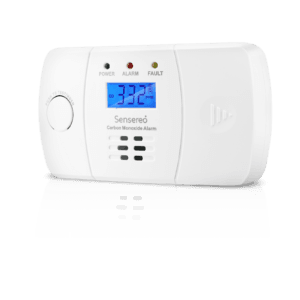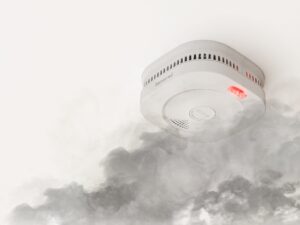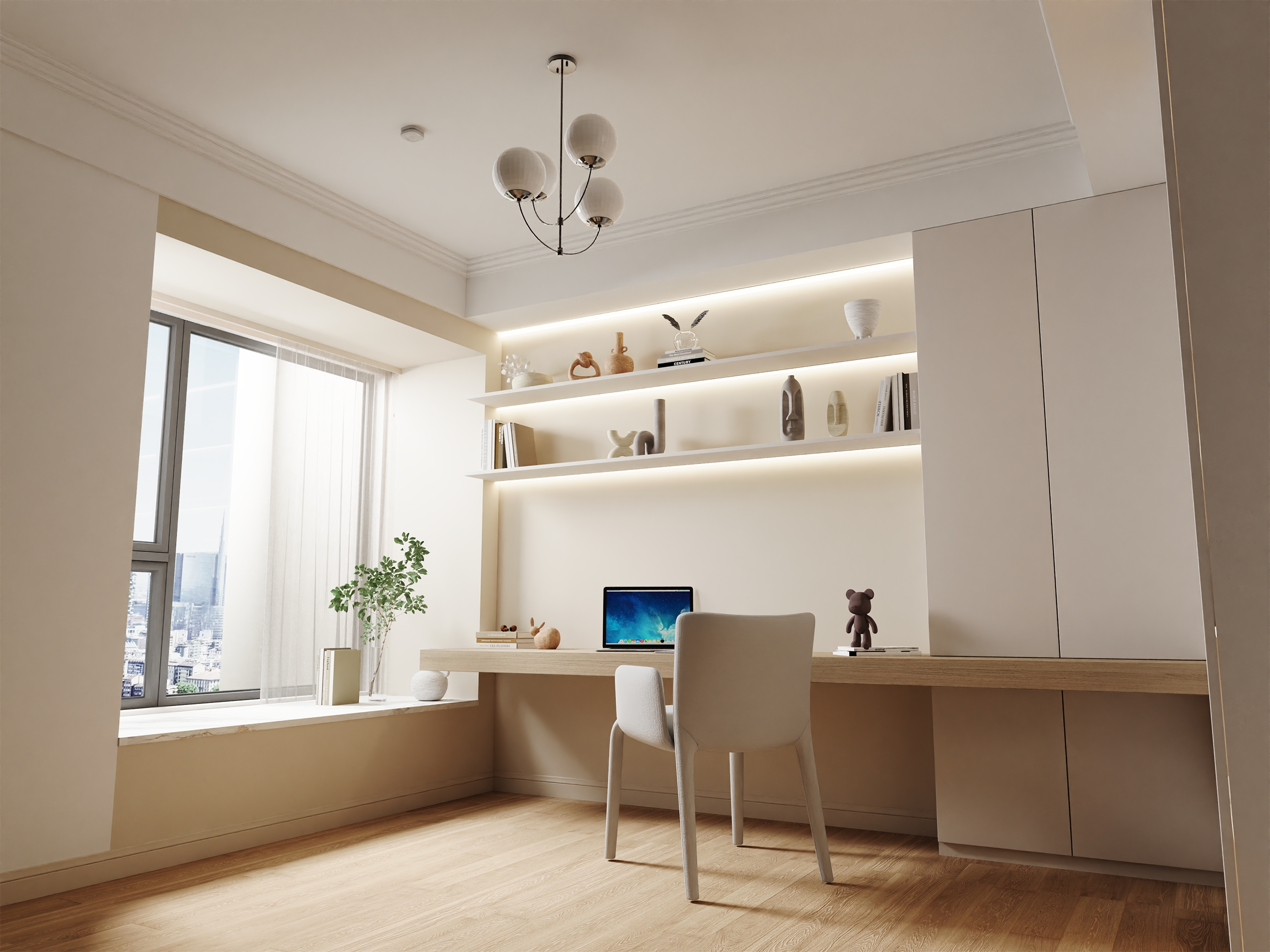Did you know? Carbon monoxide (CO) poisoning causes over 200 deaths annually in the US, while home fires account for thousands more. Protecting your family starts with understanding two critical devices: carbon monoxide detectors and smoke alarms. This comprehensive guide explains their differences, how they work, and how to choose the best carbon monoxide detector and smart smoke detector for your home.
Key Differences at a Glance
| Feature | Carbon Monoxide Detector | Smoke Alarm |
| Detects | Invisible CO gas | Smoke particles |
| Alert Sound | Intermittent beeps (carbon monoxide detector going off) | Continuous loud alarm |
| Placement | Near sleeping areas & fuel-burning appliances | Every bedroom & home level |
| Smart Features | Mobile alerts, CO level display | Voice alerts, self-testing |
| Replacement | Every 5-7 years | Every 10 years |
How Carbon Monoxide Detectors Work
A carbon monoxide detector uses electrochemical sensors to detect CO gases which are odorless, colorless gas. When CO levels reach dangerous concentrations (typically above 70 PPM), the alarm sounds, which is what happens when your carbon monoxide detector goes off.
Why CO is dangerous:
- No warning signs– Unlike smoke, you can’t see or smell it
- Fast-acting– High levels can be fatal within 15 minutes
- Common sources– Faulty furnaces, gas stoves, generators
Best carbon monoxide detector features:
- ✔ Digital display showing real-time CO levels
- ✔ Battery backup for power outages
- ✔ Smartphone notifications (in smart models)
- ✔ UL 2034 safety certification
Pro Tip: The Sensereo’s C-1 is a top-rated CO detector for accuracy and reliability when looking for the best carbon monoxide detector.

Smoke Alarm Technology Explained
Modern smart smoke detector uses two sensor types:
- Photoelectric– Best for smoldering fires (e.g., electrical fires)
- Ionization– Better for flaming fires (e.g., grease fires)
Smart advantages:
- Remote alerts to your phone
- Voice warnings identifying danger locations
- Automatic monthly self-tests
Fire Chief Rodriguez advises: “Install both sensor types for complete protection. Test alarms monthly—it takes seconds but saves lives. Consider upgrading to a smart smoke detector for enhanced safety features.”
Where to Install Safety Devices
Smoke alarms:
- Inside every bedroom
- Hallways outside sleeping areas
- On every home level (including basement)
- At least 10 feet from cooking appliances
CO detectors:
- Within 15 feet of bedrooms
- Near (but not directly above) fuel-burning appliances
- Avoid dead air spaces near corners
It is recommenced by The U.S. Consumer Product Safety Commission (CPSC) that consumers can combine smoke and CO alarms.
What to Do When Alarms Sound
If your carbon monoxide detector goes off:
- Evacuate immediately to fresh air
- Call 911 or your gas company
- Don’t re-enter until professionals declare it safe
Check our previous blog for more life-saving tips: https://sensereo.com/community/understanding-carbon-monoxide-detector-beeps-what-do-they-mean/
For smoke alarms:
- Follow your pre-planned escape route
- Crawl low under smoke
- Meet at your designated safe spot
Real-life case: A family in Ohio survived CO poisoning because their detector alerted them at 3 AM when their furnace malfunctioned – their carbon monoxide detector going off saved their lives.

Maintenance Checklist
Keep devices reliable with these steps:
- Test monthly– Press test buttons
- Vacuum annually– Remove dust from sensors
- Replace batteries– Every 6 months (or use 10-year sealed models)
- Upgrade old units– CO detectors after 5-7 years, smoke alarms after 10
FAQs
Q: What can cause a carbon monoxide alarm to go off?
A: A carbon monoxide detector going off is caused by the presence of CO gas in the air. This gas is produced by the incomplete combustion of fuels. Common sources include a malfunctioning furnace, water heater, gas stove, fireplace, or a vehicle left running in an attached garage. Even a gas-powered generator used too close to the home can trigger the alarm.
Q: How do you know if there is carbon monoxide in your house?
A: The most reliable way to know if there is carbon monoxide in your house is by having a functional carbon monoxide detector. CO is a silent killer because it is an odorless, colorless, and tasteless gas. Without a detector, you may not be aware of its presence until you experience the physical symptoms of poisoning.
Q: What to do if your carbon monoxide detector is beeping?
A: If your carbon monoxide detector going off with a loud, intermittent beeping sound (typically four beeps in a row), it indicates the presence of a dangerous level of CO gas. You should immediately evacuate the house, ensure everyone is outside, and call 911 or your local fire department from a safe location.
Q: What are two warning signs of carbon monoxide poisoning?
A: The early warning signs of carbon monoxide poisoning can mimic flu-like symptoms. Two key signs are a dull headache and a feeling of weakness or dizziness. Other symptoms include nausea, shortness of breath, and confusion.
Q: Can dust cause a carbon monoxide detector to go off?
A: No. Unlike a smoke alarm, a carbon monoxide detector does not have a photoelectric or ionization sensor that can be triggered by dust. However, a buildup of dust on the sensor can block air from reaching it, which may interfere with its accuracy over time. It’s best to clean it annually as part of your maintenance.
Q: What’s the difference between ionization and photoelectric smoke alarms?
A: Ionization smoke alarms are more effective at detecting fast-flaming fires, while photoelectric alarms are better at detecting slow, smoldering fires. Many modern alarms are dual-sensor models that combine both technologies for the most comprehensive protection.
Take Action Today
Your next steps are simple, but they could save lives. Don’t wait for an emergency—take action today to protect your home and family.
Step 1: Check Your Current Alarms
Locate all your smoke alarms and carbon monoxide detectors to ensure you have both types of devices installed on every level of your home. Check their dates of manufacture; if the smoke alarm and carbon monoxide detector are past their recommended lifespan (10 years for smoke, 5-7 years for CO), they need to be replaced.
Step 2: Ensure Proper Placement
Verify that your alarms are in the right locations. Install carbon monoxide detectors within 15 feet of every bedroom and near major fuel-burning appliances. Place smoke alarms inside every bedroom and in the hallway just outside. Make sure both are at least 10 feet away from cooking appliances to prevent false alarms.
Step 3: Upgrade for Peace of Mind
Consider upgrading to a smart smoke detector or a combination unit. For a reliable standalone CO unit, look for a model like the Sensereo C-1. This new device offers enhanced features like digital displays, phone alerts, and automatic self-testing, providing a new level of safety for your home.
“The death rate per 1,000 reported home fires was 60% lower in homes with working smoke alarms than in homes with no smoke alarms or none that worked” reported by the National Fire Protection Association. Don’t become a statistic—upgrade your home’s safety today with a quality smoke alarm and carbon monoxide detector!
Reference:
https://www.cpsc.gov/safety-education/safety-guides/carbon-monoxide/invisible-killer



